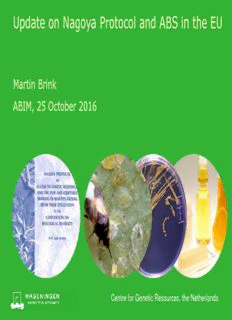
Update on Nagoya Protocol and ABS in the EU PDF
Preview Update on Nagoya Protocol and ABS in the EU
Update on Nagoya Protocol and ABS in the EU Martin Brink ABIM, 25 October 2016 Centre for Genetic Resources, the Netherlands This presentation What is ABS? International ABS agreements ● Convention on Biological Diversity ● Nagoya Protocol Implementation of Nagoya Protocol in the EU ● EU ABS Regulation ● EU Implementing Regulation ● EU Guidance Document ● EU Sectorial Guidance Documents Conclusions Centre for Genetic Resources, the Netherlands What is ABS? ABS: Access and Benefit Sharing ● regulation of access to genetic resources (GR) and associated information ● sharing of benefits from the use of these GR between providers and users Possible benefits ● monetary (e.g. royalties, funding for research) ● non-monetary (e.g. scientific co-operation, technology transfer) Centre for Genetic Resources, the Netherlands What is ABS? Example (South Africa) ● Product extract of kanna (Sceletium tortosium) used as a basis for an antidepressant (Zembrin) ● Partners HGH Pharmaceuticals South African San Council (SASC) local communities ● Access HGH gets permit for bioprospecting and export to conduct research and commercialize product ● Benefit-sharing up-front payments (before commercialization) and royalties for SASC and local communities employment creation through cultivation of kanna Centre for Genetic Resources, the Netherlands International ABS agreements Convention on Biological Diversity (CBD) The Nagoya Protocol on Access to Genetic Resources and the Fair and Equitable Sharing of Benefits arising from their Utilization (Nagoya Protocol) Centre for Genetic Resources, the Netherlands Convention on Biological Diversity (1) Objectives ● conservation of biological diversity ● sustainable use of its components ● fair and equitable sharing of the benefits Entry into force ● 29 December 1993 Membership ● 196 parties Centre for Genetic Resources, the Netherlands Convention on Biological Diversity (2) Important elements ● genetic resources no longer ‘heritage of mankind’; instead, states have sovereign rights over genetic resources ● access to genetic resources for their utilization is subject to Prior Informed Consent (PIC) of the Party providing such resources, unless otherwise determined by that Party ● access shall be on Mutually Agreed Terms (MAT) Centre for Genetic Resources, the Netherlands Convention on Biological Diversity (3) Important terms ● genetic material any material of plant, animal, microbial or other origin containing functional units of heredity ● genetic resources genetic material of actual or potential value ● Prior Informed Consent (PIC) approval, by the authorities of the providing country, of access to and utilization of genetic resources ● ‘Mutually Agreed Terms’ (MAT) agreement between two private parties under civil law contract; defining the conditions governing the use of genetic resources and benefit-sharing Centre for Genetic Resources, the Netherlands Nagoya Protocol (1) Protocol to the CBD ● elaboration of the ABS provisions of the CBD Objectives ● implementation of the third objective of the CBD: fair and equitable sharing of benefits arising from the utilisation of genetic resources Entry into force ● 12 October 2014 Membership ● 78 parties (countries + EU) Centre for Genetic Resources, the Netherlands Nagoya Protocol (2) Important elements ● compliance to be monitored by Parties to the NP (= member states) ● providing countries: simple and transparent procedures ● provisions on access to traditional knowledge related to genetic resources Centre for Genetic Resources, the Netherlands
Description: